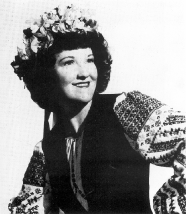|
Madelynne Greene
|
|
CLICK AN IMAGE FOR LARGER VIEW
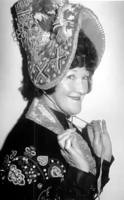 Madelynne Greene started folk dancing at the age of four in San Francisco, California. At age seven, she won a medal in a Scottish Sword Dance competition. During her high school days, she began to teach dance and would have serious ambitions along this line. She took up modern dancing and was kept busy giving concerts of her own and teaching students. She lived in New York in 1940 and 41 and noticed all the folk dance events listed in the local papers but they didn't interest her at the time (she called that her "big mistake").
Madelynne Greene started folk dancing at the age of four in San Francisco, California. At age seven, she won a medal in a Scottish Sword Dance competition. During her high school days, she began to teach dance and would have serious ambitions along this line. She took up modern dancing and was kept busy giving concerts of her own and teaching students. She lived in New York in 1940 and 41 and noticed all the folk dance events listed in the local papers but they didn't interest her at the time (she called that her "big mistake").
After returning to San Francisco, she was lured into attending a folk dance session at Changs International Folk Dancers in 1942, at that time instructed by Virgil Morton. There she got the "folk dance bug" and continued dancing and teaching folk dancing for the rest of her life, sometimes teaching five days a week. Madelynne received extensive private lessons from Mr. Morton, one of the San Francisco Bay area's early folk dance pioneers, when he realized he was going to join the U.S. Navy, and she became the group's instructor. Her charm and personality drew many devoted followers in the Bay area, and in a few years she was conducting several folk dance groups. She opened her first dance studio in San Rafael, California.
Madelynne was a teacher's teacher, and may be best remembered for her comedic rendition of the Swedish Hambo (see photo at left) in which she played several different women's "styles" during the same performance: a gum-chewing girl, an ethereal ballerina, and as the partner of an awkward jock. When Mr. Morton returned from the Navy, he became a dance instructor at San Francisco State University until he retired in 1973. He died February 22, 1981.
As the years passed, Madelynne was sought out as a teacher for folk dance camps and sessions from coast to coast. She was a thorough and understanding teacher. Madelynne was instrumental in the founding of the Folk Dance Federation of California and the teacher institutes the Federation sponsored. She also organized the Festival Workshop group, which worked on the study of costumes, development of dance techniques, and research on new dances that the group presented at Federation festivals.
Madelynne specialized in Mallorcan and Portuguese dance, but also introduced dances from the Canary Islands, China, France, Hawaii, Spain, and the Ukraine. She was the director of the San Francisco Festival Workshop (later called the Saltarello International Dance Theatre) performance folk dance ensemble. She not only taught ethnic dance but also developed dance for theater, with folklore scenes, folk singers, and dance as a dramatic presentation. Her principal dance partner was Virgil Morton.
In 1962, she founded the Mendocino Folklore Camp, patterning it after the best features from all the camps she had attended and taught, such as the Idyllwild Folk Dance Workshop, Maine Camp (now Mainewoods), the Santa Barbara Folk Dance Conference, and Stockton Folk Dance Camp.
Madelynne married poet Eric Barker in 1937. She and her husband were friends of poet Clark Ashton Smith. Eric, who had been born in 1905, died in 1973. Madelynne died during a dance lesson on February 9, 1970. Her sudden death shocked all who knew her and she was grieved by the folk dance movement to which she had given so much.
Dances Madelynne taught include Alunelul II, Ampuieții, Bak Mas, Balta, Belasičko, Biały Mazur, Blue Bonnets, Bonnie Anne (Lagach Anna), Castillana, Ceilidh, Copeo de la Muntaña, Corridnho Mar e Vento, Das Fenster, Dance de Panniere, Dance of the Aborigines, El Escondido, El Triuimfo, Fandango, Fandango Arin-Arin, Fandango Magdalena, Folias-Seguidillas-Saltonas, Gołabek, Góralski Taniec, Grechaniki, Halemaumau, Hora Boerească, Hukilau, Ingurutxo Leiza, Isas, Iskola Csárdás, Jarabe Pateño, Jarabe Tapatío, Jonkelis, Jota Aragonesa, Jota de Badajóz, Jota Mallorquina, Jota Típica, Kalena Kai, Kamarinskaya, Kjustindilska rŭčenica, Kozachok Podilsky, Kozachok Trio, Kujawiak Niebieski, Lagach Anna (An Rioghal Leanabh), Levante Tánc, Los Bailes de Ayer, Macdonald o' Sleat, Maila Baba Kogota, Malagueñas, Malhao de Saint Pedro de Mabais, Mateixa d'es Figueral, Mazur, Meitschi Putz Di, Mignon, Moja Diridika, Mon Père Avait un Petit Bois, Não Vás Ao Mar Tonho, Neopolitan Tarantella, Odessa Mazur, Orijent, Parado de Valdemosa, Paso Doble, Petronella, Polyanka, Red Boots, Ratevka, Rhechaniki, Road to the Isles, Romanian Medley, Rosinha de Carreco, Russian Peasant, Rŭčenica for Three, Ruzga de Santa Marta, Sailor's Hornpipe, Saint Andrew's Nicht, Sajonemeti Panostánc, Schuhplattler Laendler, Sedi donka, Šestinski drmeš Sajonemeti Parostánc, Schuplattler Ländler, Scottish Ramble Strathspey, Scottish Reform, Seljančica kolo, Šestinski Drmeš, Sicilian Tarantella, Solaisai na Bealtaine (Sweets of May), St. Andrew's Nicht, Svatbeni rejc, Swir Swir Mazur, Tančuj, Tanganillo-Santo Domingo-Ta Jaraste, Tanko Bushi, Tarantella di Peppina, Tarantella Napoli, Tokyo Dontaku, Trei păzește, Triumph Reel, Tsamikos (16-count - Pidichtos), Vira Cruzada, Vira de Samonde, Vira do Sitio, Vrni se vrni, and Waraku Odori.

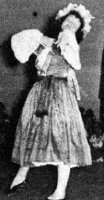
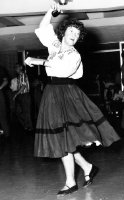
|

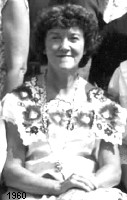


|
